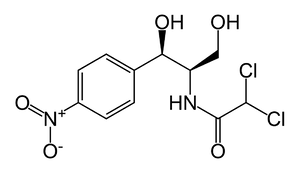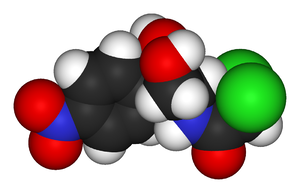كلورامفينيكول
 | |
 | |
| البيانات السريرية | |
|---|---|
| فئة السلامة أثناء الحمل |
|
| مسارات الدواء | Topical (ocular), oral, IV, IM |
| رمز ATC | |
| الحالة القانونية | |
| الحالة القانونية |
|
| بيانات الحركية الدوائية | |
| التوافر الحيوي | 75-90% |
| الأيض | Hepatic |
| Elimination half-life | 1.5-4.0 hours |
| الإخراج | Renal |
| المعرفات | |
| |
| رقم CAS | |
| PubChem CID | |
| DrugBank | |
| ChemSpider | |
| CompTox Dashboard (EPA) | |
| ECHA InfoCard | 100.000.262 |
| Chemical and physical data | |
| التركيب | C11H12Cl2N2O5 |
| الكتلة المولية | 323.132 g/mol |
كلورامفـِنيكول هو مضاد للميكروبات من النوع bacteriostatic "موقف للنمو" وليس قاتلا لها, وهو محضر من بكتريا يطلق عليها Streptomyces venezuelae، قام بفصله و تقديمه للإستعمال الطبي عام 1949 ديڤيد گوتليب. وكان بذلك أول مضاد حيوى يصنع مخلقاً على مستوى عال, كلورامفينيكول فعال ضد مجموعة كبيرة من الميكروبات، ومايزال يستعمل على نطاق واسع في بلدان عديدة ومن ضمنها مصر، نظرا لقلة تكلفته، ولكن ألغى إستعماله في الغرب تماما نتيجة تسببه في داء خطير ولكنه نادر aplastic anemia. ويتركز إستعماله في تلك البلدان على قطرات العين والمراهم لعلاج bacterial conjunctivitis.
الكلورمفنيكول نوعٌ من المضادات الحيوية المستعمَلة في علاج عددٍ قليلٍ من الأمراض المعدية. وهو يقضي على الكائنات الدقيقة التي تسبِّب الأمراض عن طريق التدخل في عمليات تكوينها للبروتين. وقد تسبِّب مادة الكلورمفنيكول آثاراً جانبيةً قاتلة، لذا يلجأ الأطباء لاستخدامها فقط في الحالات الخطيرة التي لا تستجيب للعلاج بالمضادات الحيوية الأكثر سلامة. وتشمل هذه الأمراض حمَّى التيفوئيد والتهاب السحايا وحمَّى التيفوس، ومعظم الأمراض الناجمة عن البكتيريا اللاهوائية، وهي نوعٌ من البكتيريا قادرٌ على العيش دون أكسجين.
اكتشفت مادة الكلورمفنيكول في عام 1947م، وكانت من بين المضادات الحيوية الرائدة في الاستخدام على نطاق واسع. وسرعان ما أثبتت هذه المادة أهميتها كعقار منقذٍ للحياة في مواجهة عددٍ من أوبئة التيفوس. وقد كان الأطباء يستخدمونها أيضًا في علاج أمراضٍ أخرى متنوعة، بما في ذلك التهابات المسالك البولية، ولكن اتضح بحلول عام 1950م أنَّ هذا المضاد الحيويّ يحدث أثرًا جانبيًا نادر الوقوع لكنه يكون قاتلاً أحيانًا إذ يمنع نقي العظم من إنتاج الكريات الدموية لدى مريض واحد بين كل 30 ألف حالة.
الجرعات
معايرة الجرعات
الكلرامفينيكول والكبد
الكلرامفينيكول والكلي
الكلرامفينيكول الزيتي
الكلرامفينيكول قطرات عيون
الحراك الدوائي
الاستعمالات
Although unpublished, recent research suggests that chloramphenicol could also be applied to frogs to prevent their widespread destruction from fungal infections.[1]
تأثيرات الجانبية
الأنيميا
The most serious side effect of chloramphenicol treatment is aplastic anaemia.[2] This effect is rare and is generally fatal: there is no treatment and there is no way of predicting who may or may not get this side effect. The effect usually occurs weeks or months after chloramphenicol treatment has been stopped and there may be a genetic predisposition.[3] It is not known whether monitoring the blood counts of patients can prevent the development of aplastic anaemia, but it is recommended that patients have a blood count checked twice weekly while on treatment. The highest risk is with oral chloramphenicol[4] (affecting 1 in 24,000-40,000)[5] and the lowest risk occurs with eye drops (affecting less than 1 in 224,716 prescriptions).[6] At least one internet medical source suggests that the link between chloramphenicol eye drops and aplastic anemia is "not well founded".[7]
احباط عمل نخاع العظم
سرطان الدم
There is an increased risk of childhood leukemia as demonstrated in a Chinese case-controlled study,[8] and the risk increases with length of treatment.
متلازمة الرضيع الرمادي
يترافق إعطاء الكلورامفينيكول وريدياً بما يسمى بمتلازمة الطفل الرمادي, حيث تحصل هذه الظاهرة للرضع المولودين حديثاً الخدج وذلك لعدم اكتمال الأنزيمات الكبدية لديهم, فيبقى الكلورامفينيكول بدون استقلاب في أجسامهم. وهذا ما يؤدي إلى العديد من الآثار المتقدمة,منها انخفاض الضغط, الازرقاق. يمكن تجنب حصول هذه الظاهرة بإعطاء الكلورامفينيكول بالجرعات العلاجية المحددة مع مراقبة مستوياته في الدم.
Intravenous chloramphenicol use has been associated with the so called gray baby syndrome.[9] This phenomenon occurs in newborn infants because they do not yet have fully functional liver enzymes, and so chloramphenicol remains unmetabolized in the body.[10] This causes several adverse effects, including hypotension and cyanosis. The condition can be prevented by using chloramphenicol at the recommended doses and monitoring blood levels.[11][12][13]
نظرية العمل والمقاومة
الأسماء التجارية
Chloramphenicol has a long history and therefore a multitude of alternative names in many different countries:
- Alficetyn
- Amphicol
- Biomicin
- Chlornitromycin
- Chloromycetin (U.S., intravenous preparation)
- Chlorsig (U.S., Australia, eye drops)
- Dispersadron C (Greece, eye drops)
- Fenicol
- Kemicetine (UK, intravenous preparation)
- Laevomycetin
- UK as an eye treatment
- Brochlor (Aventis Pharma Ltd)
- Golden Eye (Typharm Ltd)
- Optrex Infected Eyes
- Oftan Chlora (eye ointment)
- Phenicol
- Medicom
- Nevimycin
- Renicol (India,eye drops)
- Silmycetin (Thailand, eye drops)
- Synthomycine (Israel, eye ointment)
- Tifomycine (France, oily chloramphenicol)
- Vernacetin
- Veticol
المراجع
- ^ Kim Griggs (2007-10-30). "Frog killer fungus 'breakthrough'". BBC News.
- ^ Rich M, Ritterhoff R, Hoffmann R (1950). "A fatal case of aplastic anemia following chloramphenicol (chloromycetin) therapy". Ann Intern Med. 33 (6): 1459–67. PMID 14790529.
{{cite journal}}: Unknown parameter|month=ignored (help)CS1 maint: multiple names: authors list (link) - ^ Nagao T, Mauer A (1969). "Concordance for drug-induced aplastic anemia in identical twins". N Engl J Med. 281 (1): 7–11. PMID 5785754.
{{cite journal}}: Cite has empty unknown parameter:|unused_data=(help); Text "month Jul 3" ignored (help) - ^ Holt R (1967). "The bacterial degradation of chloramphenicol". Lancet. i: 1259. doi:10.1016/S0140-6736(67)92720-1.
- ^ Wallerstein R, Condit P, Kasper C, Brown J, Morrison F (1969). "Statewide study of chloramphenicol therapy and fatal aplastic anemia". JAMA. 208 (11): 2045–50. doi:10.1001/jama.208.11.2045. PMID 5818983.
{{cite journal}}: Unknown parameter|month=ignored (help)CS1 maint: multiple names: authors list (link) - ^ خطأ استشهاد: وسم
<ref>غير صحيح؛ لا نص تم توفيره للمراجع المسماةLancaster1998 - ^ "Antimicrobial Eye Preparations". Patient Information Publications http://www.patient.co.uk/. Retrieved 2008-05-31.
{{cite web}}: Cite has empty unknown parameter:|1=(help); External link in|publisher= - ^ Shu X, Gao Y, Linet M, Brinton L, Gao R, Jin F, Fraumeni J (1987). "Chloramphenicol use and childhood leukaemia in Shanghai". Lancet. 2 (8565): 934–7. doi:10.1016/S0140-6736(87)91420-6. PMID 2889862.
{{cite journal}}: Unknown parameter|month=ignored (help)CS1 maint: multiple names: authors list (link) - ^ McIntyre J, Choonara I (2004). "Drug toxicity in the neonate". Biol Neonate. 86 (4): 218–21. doi:10.1159/000079656. PMID 15249753.
- ^ Piñeiro-Carrero V, Piñeiro E (2004). "Liver". Pediatrics. 113 (4 Suppl): 1097–106. PMID 15060205.
- ^ Feder H (1986). "Chloramphenicol: what we have learned in the last decade". South Med J. 79 (9): 1129–34. PMID 3529436.
- ^ Mulhall A, de Louvois J, Hurley R (1983). "Chloramphenicol toxicity in neonates: its incidence and prevention" (Scanned copy & PDF). Br Med J (Clin Res Ed). 287 (6403): 1424–7. PMID 6416440.
{{cite journal}}: CS1 maint: multiple names: authors list (link) - ^ Forster J, Hufschmidt C, Niederhoff H, Künzer W (1985). "[Need for the determination of chloramphenicol levels in the treatment of bacterial-purulent meningitis with chloramphenicol succinate in infants and small children]". Monatsschr Kinderheilkd. 133 (4): 209–13. PMID 4000136.
{{cite journal}}: CS1 maint: multiple names: authors list (link)
الروابط الخارجية
- CS1 errors: unsupported parameter
- CS1 errors: unrecognized parameter
- Drugs with non-standard legal status
- ECHA InfoCard ID from Wikidata
- Infobox-drug molecular-weight unexpected-character
- Pages using infobox drug with unknown parameters
- Articles without EBI source
- Articles without KEGG source
- Articles without InChI source
- Articles without UNII source
- Articles containing unverified chemical infoboxes
- مضادات حيوية
- كلوريدات عضوية
- Nitro compounds
- الأدوية الأساسية حسب منظمة الصحة العالمية
- IARC Group 2A carcinogens